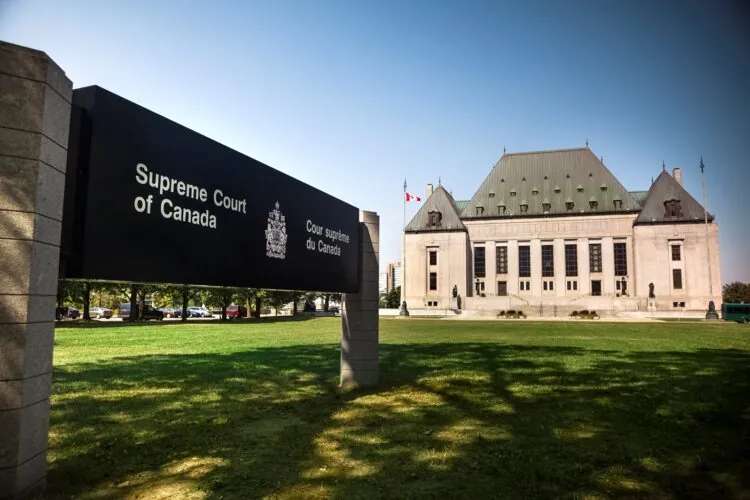Supreme Court of Canada Hears Argument in Historic Flooding Case

The Supreme Court of Canada recently heard Lac Seul First Nation’s (“LSFN”) arguments in its appeal of the Federal Court of Appeal’s decision in Southwind v. Canada.
The Supreme Court of Canada’s decision in this case could have significant implications for the damages owing to First Nations for flooding and other historical claims, particularly those involving the loss of use of reserve land.
The Supreme Court of Canada first addressed principles of equitable compensation for claims involving the Crown’s breaches of fiduciary duties to First Nations in Guerin v. The Queen.
In Guerin, the Supreme Court of Canada recognized that the Crown owes a fiduciary duty to First Nations which requires it to act in the best interests of First Nations. The Court also assessed equitable compensation for the Crown’s breaches of fiduciary duty in relation to land surrenders in accordance with the principle that the First Nation would have put the property at issue to the most advantageous use. Decisions from the Ontario Court of Appeal and the Specific Claims Tribunal have further developed the principles of equitable compensation in the context of the Crown’s breaches of fiduciary duties owed to First Nations.
LSFN’s appeal represents the Supreme Court of Canada’s first opportunity to re-evaluate these principles in more than three decades.
Background: The Construction of Ear Falls Storage Dam on Lac Seul First Nation
LSFN is Treaty 3 nation with reserve lands located on the shores of Lac Seul in northwestern Ontario.
In 1928, Canada approved the construction of the Ear Falls Storage Dam (the “Dam”) at the outlet of Lac Seul. The Dam’s construction was completed in 1929. Ultimately, the Dam caused the water levels of Lac Seul to rise 10 feet, flooding more than 11,000 acres of reserve lands.
The flooding negatively affected hunting and trapping, destroyed hay land, gardens and rice fields, and turned one LSFN community into an island.
In 1943, the Federal Government paid LSFN $50,263 in compensation for the flooded lands. The lands remain under water and will remain so for the foreseeable future. Canada made no attempts to negotiate a legal surrender of LFSN’s reserve lands, despite knowing that the Dam would cause flooding and subsequent damage to the lands.
Federal Court
In 1991, LSFN filed an action against Canada, seeking, among other things, equitable compensation for the loss of use of its reserve lands. LSFN argued that Canada’s fiduciary duties required it to negotiate a revenue-sharing agreement on its behalf with respect to the hydroelectric power generation. LSFN sought more than $500 million in equitable compensation.
The Federal Court awarded LSFN $30 million.
The Federal Court found that even if Canada had acted properly and negotiated in good faith with LSFN, the lands would still have been flooded. The Court found that Canada would not have negotiated a revenue-sharing agreement on LSFN’s behalf and that Canada would have proceeded with the project either with LSFN’s consent or by way of expropriation.
The Federal Court ultimately relied on expert evidence to assess the fair market value of the lands, primarily as bush lands, in 1929 and brought this value forward to 2017 dollars. While this came to a value of approximately $13.8 million, the Federal Court assessed additional compensation to account for the impacts to LSFN and Canada’s failure to keep LSFN informed about the Dam, consult with LSFN and act in a prompt and effective manner to compensate LSFN.
The Federal Court of Appeal’s Decision in Southwind v. Canada
A majority of the Federal Court of Appeal upheld the Federal Court’s decision. A dissenting justice would have remitted the matter to the Federal Court to re-assess the award of equitable compensation.
Lac Seul First Nation’s Appeal to the Supreme Court of Canada
LSFN appealed the Federal Court of Appeal’s decision to the Supreme Court of Canada.
On December 8, 2020, the Supreme Court of Canada heard arguments from LSFN, Canada and several interveners, including Indigenous nations and organizations and the Province of Saskatchewan.
The arguments focused on the principles of equitable compensation. LSFN argued that principles of equitable compensation required it to be compensated for the most advantageous use of the lands, which was for hydroelectric power generation, instead of a one-time payment for expropriating the lands. Canada argued that the Supreme Court of Canada should not interfere with the lower courts’ decisions.
Moving Forward
The Supreme Court of Canada’s decision in Southwind will likely be released in six to eight months. Its decision is expected to bring clarity to the assessment of equitable compensation for the Crown’s breaches of fiduciary duties owed to First Nations. The Supreme Court of Canada’s decision will affect pending and future cases involving claims brought by First Nations for equitable compensation to address historical wrongs, including matters proceeding through the Specific Claims process.
If you would like to discuss the Supreme Court of Canada hearing, its implications for historic claims against the Crown or the Specific Claims process, a member of our Indigenous practice group would be pleased to connect with you.
Note: This article is of a general nature only and is not exhaustive of all possible legal rights or remedies. In addition, laws may change over time and should be interpreted only in the context of particular circumstances such that these materials are not intended to be relied upon or taken as legal advice of opinion. Readers should consult a legal professional for specific advice in any particular situation.




